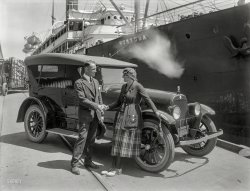
MAY CONTAIN NUTS

Search Shorpy
SHORPY ART

Framed or unframed, desk size to sofa size, printed by us in Arizona and Alabama since 2007. Explore now.
Join and Share
Ad-Free Shorpy
Shorpy is funded by you. Patreon contributors get an ad-free experience.
Learn more.

Recent comments
- Recent view
- Hudson’s Big Store
- Say what??
- Grapes?!
- A Beautiful Moment
- Such joy
- Bethune-Cookman University today...
- Yellow sky at morning
- Side Winder
- Air Quality?
- Sojourner Truth riot
- None were so blind(ed)
- The less famous sister
- Good ol' days?
- Rise and Fall
- Goo Goo Ga Joob
- Ticket Retention
- Not the only one
- Vagaries of War
- Killed by Amtrak
- Back to the Future
- Wanted --
- If you can't stand the light
- Centralized Traffic Control, I believe
- What's really happening
- Heckuva remote control!
- Sometimes — Things Go Bump!
- I SEE THE LIGHT
- Union Switch and Signal Company
- Get That Light Out Of My Eyes
Member Photos
The Shorpy
Print Emporium
Print Emporium
Search Shorpy
Search results -- 30 results per page
- Let It Slide: 1920
- San Francisco circa 1920. "Locomobile touring sedan." An expensive open car fortified against the elements with yet ... "California top." 5x7 inch glass negative by Christopher Helin. View full size.
Lost in Translation The brand Locomobile ... Posted by Dave - 10/14/2016 - 11:26am -
![Let It Slide: 1920 San Francisco circa 1920. "Locomobile touring sedan." An expensive open car fortified against the elements with yet another variation on the so-called "California top." 5x7 inch glass negative by Christopher Helin. View full size.
Lost in TranslationThe brand Locomobile makes me think back to stories of how Chevrolet supposedly marketed the Nova to Mexican consumers without realizing that no va implies "doesn't go" in Spanish. I wonder what the same market would make of a "loco" mobile?
["Locomotive" in Spanish is "locomotora," so probably not much. - Dave]
[And Snopes pretty well debunks the Chevrolet "no va" business. - tterrace]
Very pretty car I have read that Locomobile prices ranged from $5,000 to $12000 in the 1920s, about as expensive as a new house at the time.
The Locomobile is also reported to be the car that inspired Walter Chrysler to start his own car company in 1925.
Not really lost in translationInteresting. As a Mexican I never heard or thought of the Nova name in any negative connotation. That "No Va" story sounds more like something invented by an American who pretends to know how the primitive Mexicans think, and trust me, his interpretation is completely wrong.
No; the name had nothing, or very, very little to do with the car's failure in the Mexican market, and that "failure" is very relative, because the automotive market was very small and there was very little competition here at the time: we had only 3 other medium-sized cars, namely the Ford Maverick, the Chrysler / Dodge Aspen, and the local incarnation of the AMC Hornet.
The Nova didn't sell well here not because of the name, but due to other factors, build quality, gas consumption and odd design among them, not to mention the recessive Mexican economy in the 1970s.
Now, If we were going to find meanings to the name of things (which we normally do not), the word "Nova" has at least two other possibilities more relevant to us 1970s Mexicans than the "No Va" fairy tale:
1. Nova is a Latinization of Nuevo, which means New. So it could have been said that to us the Nova was the Chevrolet Nuevo (New).
2. Back then Nova was the brand name of the standard (80) octane gasoline sold in Mexico.
As for a car called Locomobile, it would hardly raise an eyebrow here; for the most part we don't give much of a thought for the name of things. But in very few occasions some memorable names become so familiar that they become synonimous to the whole kind of product they represent; for example a paper tissue will be called a "Kleenex" independently of the actual brand of the product. But those are very rare instances, so I doubt we would call "locomobiles" to all the cars on the streets.
Buster Keaton filmed The Navigator hereThis home, 2505 Divisadero, portrayed the home of Buster Keaton's girlfriend in The Navigator (1924). Buster's character lived in the home of A.D. Moore, 2500 Divisadero, when that mansion took up the entire east side of the street.
You can read about this filming spot on my blog post https://silentlocations.wordpress.com/2014/05/12/keatons-heart-in-san-fr...
(The Gallery, Cars, Trucks, Buses, Chris Helin, San Francisco)](https://www.shorpy.com/files/images/SHORPY-1053.thumbnail.jpg)
- Grant Six: 1920
- Somewhere around San Francisco in 1920. "Grant Six touring car." Pointed straight into the 20th century, although the Grant brand ... world, expiring in 1922. 5x7 glass negative by Christopher Helin. View full size.
Once Rail, Now Bike Trail. Today's bike trail ... Posted by Dave - 09/28/2014 - 12:21pm -
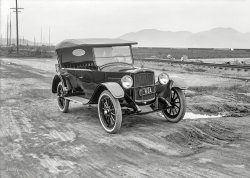
- Buggy Buffet: 1919
- San Francisco, 1919. "Grant Six touring car at Alta Plaza Park." Manifesting a variety of conveyances for young ...
(The Gallery, Cars, Trucks, Buses, Chris Helin, Kids, San Francisco) ... Posted by Dave - 05/04/2017 - 11:35am -
![Buggy Buffet: 1919 San Francisco, 1919. "Grant Six touring car at Alta Plaza Park." Manifesting a variety of conveyances for young and old, in this latest psalm from the Shorpy Bible of Bygone Buggies. (Footnote: running-board doormat.) View full size.
Dealer License PlatesThe earliest dated ones that I have seen.
[California dealer plates with both the word and the date were first issued in 1915. -tterrace]
Love the descriptionShorpy has the best descriptions. "Shorpy Bible of Bygone Buggies". I also particularly liked "Forgotten Phaetons" and "Brobdingnagian Broughams".
And The Dealer Is ...Frank O. Renstrom, who was previously seen here. The driver seems to be Renstrom.
The entrance to the park behind the car appears to be at Washington and Steiner streets:
(The Gallery, Cars, Trucks, Buses, Chris Helin, Kids, San Francisco)](https://www.shorpy.com/files/images/SHORPY-1164.thumbnail.jpg)
- A Merry Young Soul: 1917
- ... has what is an exceedingly rare auto, a 1915 Cole 4-40 touring car, which might be the only one left in the world. That is the ... in existence.
(The Gallery, Cars, Trucks, Buses, Chris Helin, San Francisco) ... Posted by Dave - 06/02/2016 - 7:50pm -
![A Merry Young Soul: 1917 San Francisco circa 1917. "Cole Eight Toursedan at Golden Gate Park." Latest epistle in the Shorpy Bible of Brobdingnagian Broughams. View full size.
Shadows and FDRI'm surprised the photographer's shadow is so prominent. Guess I presume that professional photographers are more diligent about aspects like that - distracting things in foreground, etc. I'm guessing this shot wasn't used for any published purpose.
[Would be easily dealt with in preparing the photo for newspaper publication, as was the intent. Lighting, background and composition were more important factors for the shoot itself. -tterrace]
Living FossilA friend of mine here in the Detroit area has what is an exceedingly rare auto, a 1915 Cole 4-40 touring car, which might be the only one left in the world. That is the original color - not every early car was black.
Always wanted to put a bumper sticker on it "Powered By COLE."
Cole 8The Cole was a high quality auto made in Indianapolis. Before WWI there were only a few autos that had the unusual V8 engine. There were earlier V8s but it was Cadillac that developed in great secrecy and "revealed" the American V8 in 1914 (a little later used in Oldsmobiles and Chevrolets.
In '24 a Cole was the Indy 500 pace car but that was getting close to the end of the Cole company's life. There are about 60 Coles left in existence.
(The Gallery, Cars, Trucks, Buses, Chris Helin, San Francisco)](https://www.shorpy.com/files/images/SHORPY-978.thumbnail.jpg)
- Dorts and Dolls: 1923
- San Francisco circa 1923. "Dort touring car at Golden Gate Park." Latest chapter in the Shorpy Saga of ... -tterrace]
(The Gallery, Cars, Trucks, Buses, Chris Helin, San Francisco) ... Posted by Dave - 10/06/2015 - 10:11am -
![Dorts and Dolls: 1923 San Francisco circa 1923. "Dort touring car at Golden Gate Park." Latest chapter in the Shorpy Saga of Superannuated Sedans. 5x7 glass negative. View full size.
The Gray oneswere built about 30 miles from my home.
https://en.wikipedia.org/wiki/Gray-Dort_Motors
Slight correctionSorry, Dave, but that's a Dart. A Dadge Dart.
All kidding aside, these lesser-known cars of Frisco are super interesting, with unexpected cool elements. That one a few cars back with the horn going through the bodywork is an example of what I mean.
I realize there were darn good cost/hassle reasons why car makers stopped using nitrocellulose lacquers, but they sure made for a beautiful finish when new. Can't imagine trying to maintain it. But I wait for you to find a nifty sunburst finished suto to match my old Mosrite guitars!
No Where ElseIs the Golden Gate park the only place in SF to take automobile photos?
[No, also the hills. -tterrace]
(The Gallery, Cars, Trucks, Buses, Chris Helin, San Francisco)](https://www.shorpy.com/files/images/SHORPY-714.thumbnail.jpg)
- At Anchor: 1919
- ... wheels-up in 1922.
San Francisco, 1919. "Saxon touring car at boatyard." Today's entry on the Shorpy Roster of Musty Marques. 5x7 glass negative by Chris Helin. View full size.
Star Plated in 1919 The encore of the car and ... Posted by Dave - 07/31/2017 - 5:59pm -
![At Anchor: 1919 Saxon, the seventh largest American car maker in 1917, went wheels-up in 1922.
San Francisco, 1919. "Saxon touring car at boatyard." Today's entry on the Shorpy Roster of Musty Marques. 5x7 glass negative by Chris Helin. View full size.
Star Plated in 1919The encore of the car and gentlemen previously seen along the docks here. With the license plate now visible we know that the vehicle belonged to Mr. Charles E. O'Day of 1763 Geary Blvd., San Francisco. At the time the photo was taken he was a salesman at DuBroy Motor Company, Inc.
DuBroy Motors started out as the Saxon Sales Company circa 1916 at 690 Van Ness. President and general manger was Francis Louis DuBroy. By 1917 the company had moved to 1529 Van Ness Ave which was the southeast corner of Van Ness and California at the time. In addition to the Saxon the dealership was also selling Nash automobiles. By 1920 the firm had relocated again to 1290 Sutter with a service department at 1615 Pine. The old location on Van Ness became the Pacific Nash Motor Company so it appears that DuBroy either lost or sold his Nash distributorship.
Prior to working at DuBroy Motors Charles O'Day had worked as a chauffeur since at least 1909. He stayed on at Pacific Nash when DuBroy moved his business, and he later became the sales manager for the dealership. We know he left that firm around the year 1933 as he had become the sales manager for James W. McAlister Chrysler and Plymouth by sometime in either 1933 or 1934. He remained there into at least 1944. By 1945-1946 he was with George S. Daniels Pontiac Motor Sales which became Weltner Pontiac circa 1954. Weltner was located across the street from the former DuBroy dealership when it was on Van Ness with an address at 1560 Van Ness (with street renumbering still at California & Van Ness).
So, 25 years after O'Day started selling cars, he was right back where he began. He remained at Weltner into at least 1954, but he later sold cars at McAlister Buick from about 1955 - 1958 and Volkswagen cars for Reynold C. Johnson during the years 1959 - 1968. By 1971 he was retired, he died on September 2, 1982, and he was buried in Colma, California along with his wife Leona who died in 1976.
A feature in the UPI archives on the 75th anniversary of the 1906 San Francisco Earthquake included a story from O'Day. "Charles O'Day told of how his family lost their house but happened to have crates of dishes in the wreckage. In the following months, the dishes were sold piece by piece and produced $1,600 with which the family opened a restaurant."
Vanity License PlateThe 'STAR' embossed on the license plate indicates the men were law enforcement officers, detectives, etc.
[No, the star is a validation tab to indicate vehicle registration for the year 1919. -tterrace]
Getting in on the ground floor...as a Saxon dealer in the small town of Waldron, Arkansas, circa 1914.
(The Gallery, Boats & Bridges, Cars, Trucks, Buses, Chris Helin, San Francisco)](https://www.shorpy.com/files/images/SHORPY-1200.thumbnail.jpg)
- Two Dourpower: 1919
- San Francisco circa 1919. "Mitchell touring car at Golden Gate Park." Latest entry in the Shorpy Cavalcade of ... car.
(The Gallery, Cars, Trucks, Buses, Chris Helin, San Francisco) ... Posted by Dave - 10/11/2015 - 11:44am -
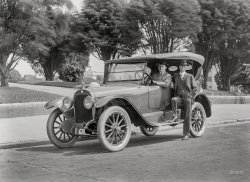
- Old & New: 1930
- San Francisco circa 1930. "1921 Cadillac touring car." A well-worn example (equipped with Horse Shoe Cord tires and a ... Street.
(The Gallery, Cars, Trucks, Buses, Chris Helin, San Francisco) ... Posted by Dave - 06/12/2017 - 8:19pm -
![Old & New: 1930 San Francisco circa 1930. "1921 Cadillac touring car." A well-worn example (equipped with Horse Shoe Cord tires and a fold-away steering wheel) at the address also seen here. The subliminal message in this image is that certain things that are a habit can also be a joy. For extra credit: What things? (The answer, discerned by our sharp-eyed commenters, is: Dinnerware. Also, the high-rise in the distance is the Cathedral Apartments at 1201 California Street, completed in 1930.) 5x7 glass negative. View full size.
Mother's DayI found two mentions of the dinnerware advert - both behind a paywall. But the ad text reads as follows:
Light up her eye? with a wonderful surprise ! 'Make this Mother's Day really memorable by gifting Mom with something she's always wanted . . . but never really expected . . . a set of new dinnerware ! Remember- "Old dinnerware is a habit - new dinnerware is a joy "
The phrase appeared in both a 1929 newspaper and a 1956 newspaper, so the advertising campaign was rather long-lived.
I wonder how many Moms throughout the years displayed their 'joy' by chucking the old dinnerware at Dad for being so chauvinistic?
Dinnerware"Old dinnerware is a habit. New dinnerware is a joy."
Is it --Dinnerware?
"Outdoors All Year Round"The outdoor poster billboard in the photograph was one of many maintained by the firm of Foster and Kleiser, begun in 1901 and transformed eventually into the Clear Channel Outdoor Advertising Company.
Two short chronologies:
http://notablekleisers.blogspot.com/2007/08/foster-and-kleiser-outdoor-b...
http://company.clearchanneloutdoor.com/our-history/
In the mid-1920s, Foster and Kleiser published an extensive analysis of the Pacific Coast advertising market. Their detailed study, complete was billboard samples, is:
https://babel.hathitrust.org/cgi/pt?id=mdp.39015041908370;view=1up;seq=1
Digital images of their billboards are in the:
http://library.duke.edu/digitalcollections/oaaaslidelibrary_SLA1847/
Oddest Tire BrandThe muddy back wheel says "Horse Shoe Cord Tire" on its sidewall. I get it that the tire is to the wheel as the shoe is to a horse's foot, but why that would be an appealing way to market a car product does not seem to translate well today.
As for the habit/joy -- what about his cigar?
[The answer, as noted by the commenters below, is Dinnerware. -Dave]
One of these things doesn't belongShiny shoes aside, the man doesn't appear much concerned with his appearance if the press of his suit is any indication. The car, while a premium make, also bears the mark of benign neglect.
The woman, on the other hand, is very, very Nob Hill indeed. Perhaps her perpetually-between-jobs brother is visiting and she's condescended to go for a ride with him.
It's the treadThe Racine Auto Tire Co. (name also seen on tire) of Racine, Wisconsin used the brand name "Horse Shoe Tire", which corresponded to its signature tread pattern. Here is a 1919 ad.
Cathedral Apartments, Nob HillI'd been thinking the woman's hat, all by itself, dated this image to 1928-30 rather than 1921. Eventually I realized, confirming this, that the skyscraper in the distance was 1201 California Street, completed in 1930, seen from the southwest. The pic's location is probably smack in the middle of the Western Addition, largely cleared for housing projects starting in the 1950s. Possibly the address was 1150 Webster Street.
(The Gallery, Cars, Trucks, Buses, Chris Helin, San Francisco)](https://www.shorpy.com/files/images/SHORPY-1178.thumbnail.jpg)
- New Arrivals: 1920
- San Francisco circa 1920. "Grant Six touring cars after unloading." Latest tenants in the Shorpy Garage of Ill-Fated ... railcars.
(The Gallery, Cars, Trucks, Buses, Chris Helin, Railroads, San Francisco) ... Posted by Dave - 07/23/2016 - 12:59pm -
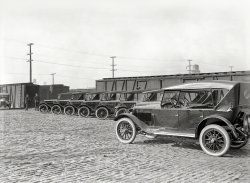
- Stop Ahead: 1925
- San Francisco, 1925. "Jewett touring car from rear." Going forward, the end of the road for the Jewett brand ... speechless.
(The Gallery, Cars, Trucks, Buses, Chris Helin, San Francisco) ... Posted by Dave - 06/29/2016 - 10:07pm -
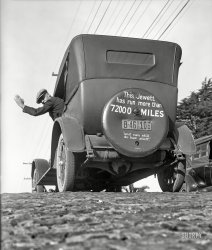
- Standard Equipment: 1920
- ... railroad rolling stock. 5x7 glass negative by Christopher Helin. View full size.
A Very Nice Example of "Perpendicular Period" ... doors) substantially more expensive than roadsters and touring cars. Also, this type of construction deteriorated rapidly except ... Posted by Dave - 01/23/2017 - 9:54pm -
![Standard Equipment: 1920 There is something about the snug click of the door latch and the clean, windless interior of a closed car that makes you feel at home and comfortable in there. The deep-cushioned seats, the curtains, the glass, the conversation in low tones -- all these things make getting somewhere as pleasant as being there. Getting home is never a problem, and the weather is but an incident. In the Standard Eight Coupe, Sedan or Sedanette, the powerful motor carries the extra burden of a closed body with an effortless ease ...
-- "People Don't Regret Buying Closed Cars" (Ad from 1921)
San Francisco circa 1920. "Standard Eight sedan at Golden Gate Park." The Standard ("Monarch of the Mountains"), manufactured in Butler, Pennsylvania, from 1912 to 1923, was a product of the Standard Steel Car Company, maker of railroad rolling stock. 5x7 glass negative by Christopher Helin. View full size.
A Very Nice Exampleof "Perpendicular Period" styling.
[Early Perpendicular. - Dave]
Like Sliced BreadIt's amazing to think that enclosed automobiles came later, even though enclosed carriages had been around for centuries. I have to assume it was a cost issue. Or maybe weight?
No regretsYou had me at door latch.
The old lady in backShe can remember covered wagons! I often wonder what the 20th century seemed like for people born in the 1830's and 1840's who lived long enough to see all the modern advancements. My mother's grandmother died at 96 in 1927, still living by herself in a gaslit house where she cooked every meal from scratch on a wood stove.
"Conversation in low tones"Really a lost art.
Closed carsThey were always available, as soon as cars of sufficient size began to replace motorized buggies.
Riding in a dry place with no wind was always a strong attraction, but closed cars faced a whole list of barriers that did not really break down until the later 1920s.
Almost all early bodies were framed in wood with elaborate joints and much bracing to keep doors functional and joints tight through the racking of driving on mostly bad roads.
This the bodies (especially four doors) substantially more expensive than roadsters and touring cars. Also, this type of construction deteriorated rapidly except perhaps in cars used only on city streets, and they soon succumbed to sagging doors, leaks, and general debilitation while their open bodied brothers were still functional.
Safety was also a major concern. Safety glass was still in the future, and the worst and commonest closed car crash injuries were caused by big, razor sharp chunks of plate glass flying around, often causing catastrophic bleeding.
Changeover to stamped steel construction moved rapidly in the later 1920's and rapidly reduced costs and improved rigidity and durability. Small scale uses of various types of safety glass came along, and at the end of the decade Ford moved to safety glass (driven by glass injuries to a Ford manager, I think) windshields and then as rapidly as production volume caught up to full use of safety glass. Just from observation I would say that our auto fleet moved to a very strong domination by closed cars in maybe 5 years, say 1925-1930.
By the way, all those failing wood framed sedans I mentioned had their bodies cut away and became the home-made open trucks preferred by all the folks in Shorpy pictures of migrating Okies.
[Mass-produced all-steel bodies made their debut in the mid-1930s, starting with General Motors' "Turret Top" cars of 1935. Up until then, roofs on closed cars were generally made of rubberized fabric stretched over a wooden frame. - Dave]
(The Gallery, Cars, Trucks, Buses, Chris Helin, San Francisco)](https://www.shorpy.com/files/images/SHORPY-1081.thumbnail.jpg)
- Ahoy, Matey: 1921
- "Jordan touring car at San Francisco piers, 1921." The S.S. Ventura at dock. 8x6 ... at 2080 Washington St., the backdrop for many a Chris Helin photo of Antique Automotive Anachronisms seen here.
Love the saddle ... Posted by Dave - 04/14/2017 - 5:45pm -
